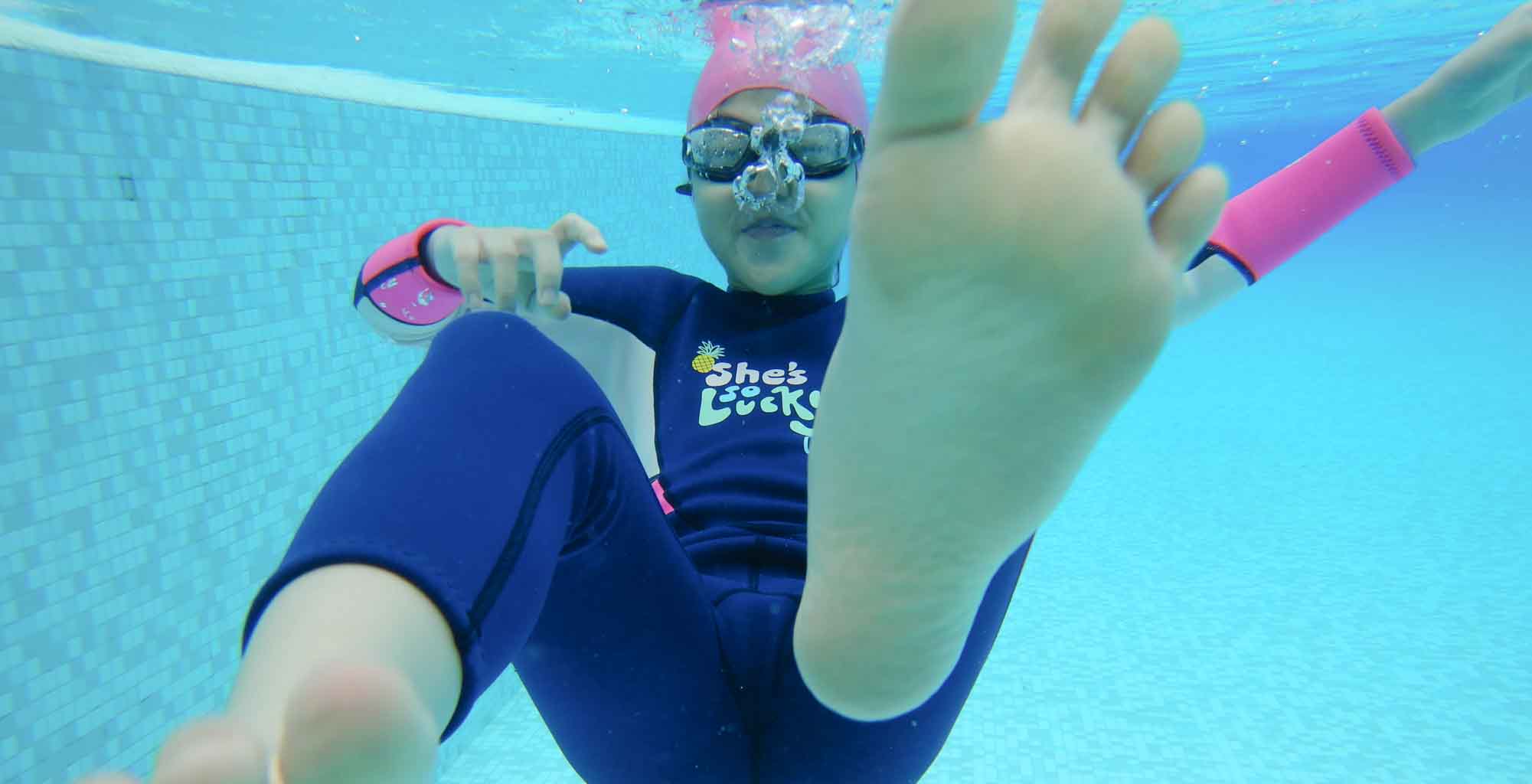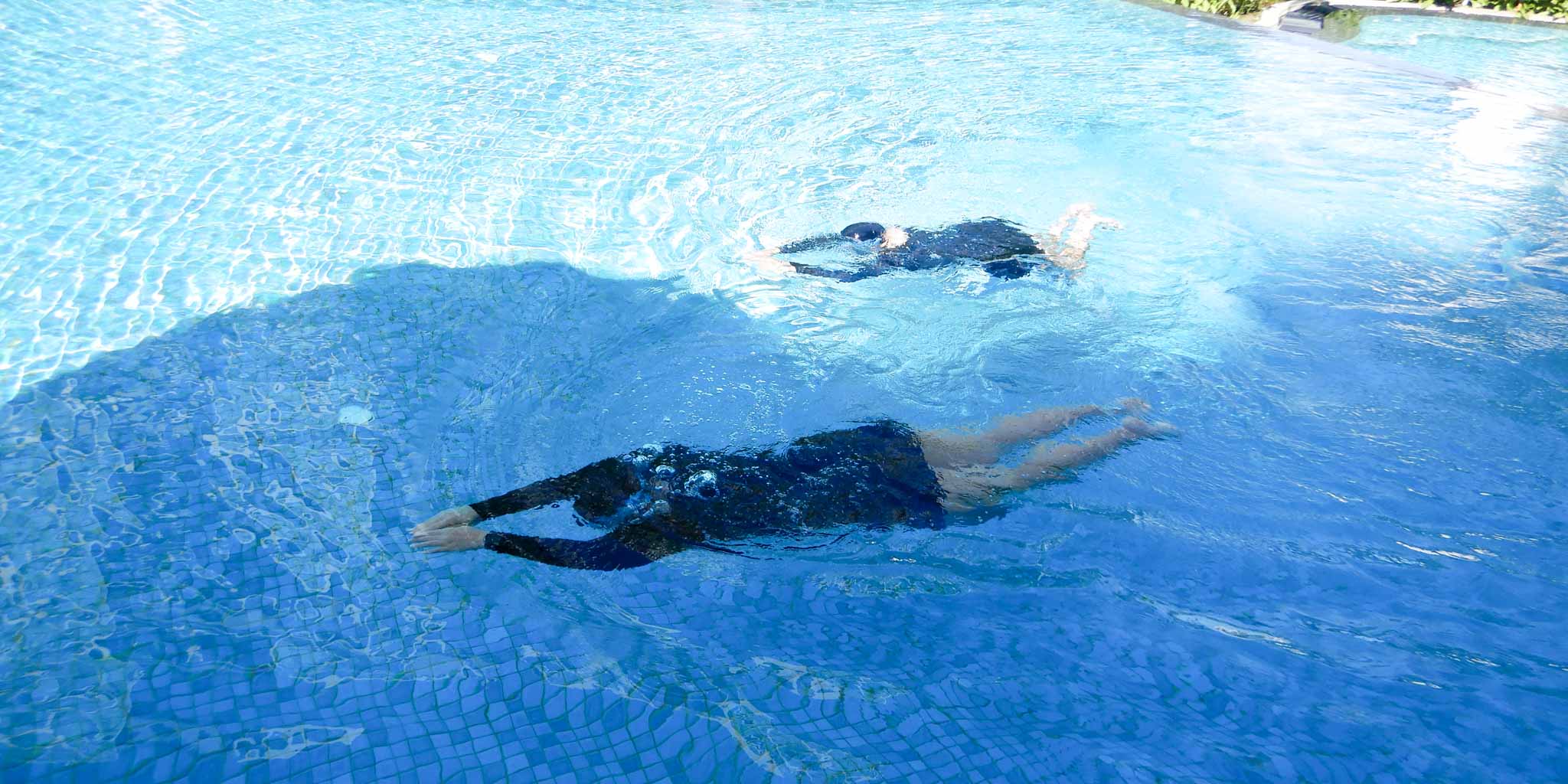Master Swimming Technique: Butterfly
“I knew I was doing a good job. If I kept to my beat, it would get me through” – Misty Hyman won the Olympic gold medal in 2000.
Some things that make an excellent butterfly stroke are rhythm, flow, and ease. Misty Hyman didn’t think about pushing faster or getting stronger when being chased by the favorite for the gold medal in the 200-meter butterfly at the 2000 Olympics in Athens. She kept her lead in one of the biggest upsets in the history of Olympic swimming by paying attention to the flow of her strokes. When swimming butterfly, swimmers with good rhythm can move through the water with little resistance, use their power at the right times, and, perhaps most importantly, relax during other parts of the stroke.
This blog post talks about how to position the body, kick, breathe, and use the body’s core, or center, for stability and strength. The butterfly kick, also called the dolphin kick, is fun and a great way to improve your core. Once a swimmer is comfortable with the core rhythm and kicking, they should focus on arm movement, tempo, and time of the full stroke.
If you’re new to the butterfly or don’t have a lot of flexibility, you might want to use fins while you learn it. With swim fins, you can feel the kick moving through your legs, knees, and feet.
Shorter fins are better because they help keep the speed of the kick and, by extension, the short time. Don’t try to move quickly through the water while wearing fins. Instead, keep your energy from your core and let it run through your hips through your legs and fins. Fins are not made to help you swim faster. Instead, they help you feel the flow of your strokes better.
The butterfly can be a lot of fun if it is done with an easy flow and pace. Too often, swimmers try to do the butterfly stroke with their shoulders and arms, which is not fun and can hurt them. Stay focused on core rhythm, rhythm, and forward motion; you will learn to swim a great butterfly.
Some things that make an excellent butterfly stroke are rhythm, flow, and relaxation.
The butterfly is one of the trickiest swimming strokes to perfect because it demands precise technique and superb rhythm. However, balancing power and grace is probably the most beautiful stroke.
Swimmers call it the “fly” because it needs two dolphin kicks followed by synchronized arm movements. Swimming the “fly” is incredibly gratifying; here are five simple steps to teach you how to perfect this technique.
Step 1: Position Your Body
Maintain a flat body and lie face down in the water, keeping your body in line with the water’s surface.
Step 2: Arm Motion
Keeping the arms in time with the core movement is crucial to keeping the butterfly stroke calm and sustained. The section examines a whole stroke cycle, beginning and ending right after your hands enter the water at the top of the stroke, to study the mechanics of the butterfly’s arm action. This pattern helps you to concentrate on one stroke cycle at a time before gradually progressing to swimming the entire stroke.
Your hands and arms enter the water at the start of the stroke cycle, your chest presses down, your hips are on the water’s surface, and your legs end the snap of the kick. Your hands automatically spread, forming a Y position slightly beyond your shoulders. This portion of the stroke feels like you’re gripping the sides of an open doorway with your hands and leaning through it with your chest. Although you do not truly stop moving during this phase, you may feel as if you are as you ride out the momentum of the previous stroke cycle and prepare for the next. Beginning butterfly swimmers frequently make mistakes by racing through or altogether ignoring this important body extension, chest press, and quick stop. This blunder made achieving a rhythmic and flowing stroke difficult.
Like any other stroke, a proper catch will prepare swimmers for a more forceful and efficient butterfly. Like freestyle catchers, Butterfly swimmers retain a high-elbow position while pressing their fingertips, hands, and forearms down and slightly out to grip the water for the underwater pull efficiently. The hand posture at the broadest in the catch phase is commonly referred to as the corner. Swimmers maintain the high-elbow position by pulling their arms back from the corner and under the body during the underwater part of the stroke. They then push their arms back and out to complete the stroke. Swimmers hold their hands a hand’s width apart in front of their tummies as they transition from pull to push.
The chest moves from the lowest undulation point to the highest point, just above the water’s surface, during the underwater phase of the stroke. Your hands must accelerate to their maximum speed through the forceful press until the stroke completion. As you transition into the recovery, the acceleration of your hands and forearms from the slower catch to the faster finish offers maximum power and lift. Take a quick breath during a breathing stroke cycle while your chest goes up and above the water and your hands speed through the push portion of the stroke.
In the butterfly, the arms are straight, relaxed, and in line with the shoulder blades, the pinky fingers are up, and the backs of the hands are leading forward. During the recovery, the arms should be barely above the water’s surface. Resist the urge to bend your elbows as you would in freestyle by visualizing yourself making a snow angel:
Hold your elbows straight and draw large semicircles with your fingertips on either side of you. To ride the surge of force to the front of the stroke, relaxation is crucial during this part of the stroke. Consider flinging your arms in front of you as your chest travels forward over the water. At the same time, your arms, chest, and head should reach the front of the stroke and the water’s surface.
The arm movement, like the front crawl, has three steps: catch, pull, and recovery.
Catch – With your arms out straight, shoulder width apart, and palms facing down, press down and out with both hands simultaneously.
Pull – In a semicircular motion, pull your hands towards your body with palms facing outwards, keeping your elbows higher than your hands.
Recovery: When both hands reach the upper thighs at the end of the pull, simultaneously sweep both arms out and over the water and throw them forward into the starting position. Ensure your palms are pointing outwards so your thumbs are the first to enter the water.
Step 3: Breathing Method
Breathing can be difficult because it must be timed and executed swiftly. The proper time to take a breath is at the beginning of the recovery phase when the arms are just beginning to emerge from the water. Raise your chin above the water, keeping your gaze straight and not turning to the side.
Butterfly breathing, like other strokes, must be synced with the rhythm of the stroke. Please keep your eyes down on the water and inhale when your chest is at its maximum point of undulation. Visualize a long, wrinkle-free neck as you inhale.
Maintain a long, straight neck and lead with the top of your head. Exhale softly as you press your chest and lungs back beneath the water’s surface. Accelerate the air passage and expel the remainder with a final puff, then inhale as your chest returns to its original position. Relax your face and jaw muscles, concentrate on inhaling and exhaling, and keep a constant, pulsating beat.
Begin kicking by keeping your arms at your sides and breathing on every fourth upbeat of your legs. Kick with your arms extended in front of you next. Breathe again after every fourth kick. Reduce any disruption to the undulation’s flow by inhaling swiftly and exhaling softly as you press your face under the water.
Butterfly kick drills will benefit all swimmers, whether they train on their backs, underwater, horizontally, or vertically, as discussed later in this article. The dolphin kick was recently added to the underwater withdrawal of breaststroke, as well as freestyle and backstroke starts and turns, so it can now be used in all strokes for masters competitions.
Step 4: Leg Movement
When done correctly, the butterfly kick blends seamlessly into the undulating rhythm. Keep your arms at your sides, visualize your legs as an extension of your chest and hips, and allow the energy to run whiplike through your thighs, knees, shins, ankles, and toes. With this release of energy, imagine your legs unfurling and unrolling. As you lower your chest, your feet complete their final snap, and your hips sit high on the water’s surface. As your chest lifts, your legs should rise together, with your knees straight. Work your leg muscles by doing both up and down movements. The most common error made by new butterfly swimmers is starting the kick from the knee. Keep your legs straight and connected to your core as you move them with the strength of your abdominal and hip muscles. Ideally, your knees should be relaxed enough to allow your core’s pulsing activity to go down your legs. Keep the undulations’ height to a minimum and focus on forward movement.
To master the butterfly leg action, envision yourself as a dolphin or mermaid with only a tail! Then, kick down with both legs together, and toes pointed simultaneously.
The first kick is tiny to help you balance your body once your arms enter the water.
The second kick is big, delivered when your arms are over the water during recovery. Finally, the massive kick aims to keep propelling your body forward even if momentum is lost during recovery.
Step 5: Make a wave-like movement with your body.
Be one with the current. As you swim, your entire body should form an undulating S shape. Allow your instincts to take over and move with the flow of the action like you would when dancing. Your strokes will be more efficient and less taxing if you can find your rhythm and connect both body motions with your limbs.
Freestyle & Butterfly Drill To Improve Body Position and Kicking!
Dolphin Freestyle
THE OBJECTIVE OF THIS DRILL
- The kick and the arm stroke must be coordinated.
- synchronizing the stroke rhythm with the kick
- Utilizing the kick’s momentum to help the arm stroke
HOW TO PERFORM THIS DRILL
Step 1: Push off the wall, arms extended, core engaged, in preparation for freestyle. Do six to twelve strong dolphin kicks. While keeping your feet connected to the water, concentrate on delivering a rhythmic kick with a compact yet strong downbeat. Keeping your head stable and not bouncing too much during this workout.
Step 2: After you’ve developed a robust and rhythmic kick, start a freestyle arm stroke. Timing your kick such that you produce one kick with each arm stroke. This is not the same as the butterfly stroke rhythm. Once you’ve matched a kick to each arm stroke, time the downbeat of each kick to exactly when your hand strikes the water in front of you.
Step 3: Go to the opposite end of the pool, concentrating on combining these two moves. Repeat until the freestyle arms and dolphin kick are appropriately coordinated and have a consistent beat. When the downbeat of your dolphin kick is timed to the entry of your hand in front, you reach forward with more momentum, urging you to extend farther and for a longer period. Also, while you’re focusing on timing your kick to the reaching arm, remember that the same kick also assists the stroking arm, accelerating to the back of your stroke.
Step 4: Go through the drill again. Increase the tempo of your kick. Adjust your arm stroke to match the faster rhythm. Plant your foot behind you while you place your hand in the water before you.
Step 5: Repeat the synchronization with a flutter kick. While it is normal to use more than one flutter kick per arm, for each stroke, make sure that one of your kicks fits the entry of your hand and simultaneously aids the fast finish of the other hand. Swim many lengths of the pool.
CHART OF DRILL FEEDBACK
Problem: My dolphin kick appears to be out of place.
Modification: If you perform this correctly, your hips will roll, as they should in freestyle, causing the dolphin kick not to be up and down. That’s OK. The drill’s goal is to match the kick rhythm to the arms.
Problem: When I do the flutter kick, I make the simultaneous move with the same side arm and leg.
Modification: This is OK. It all depends on how many flutter kicks you do per stroke. The average number of kicks per arm is three, while many swimmers do two or four. Some people even do three on one side and two on the other. This timing can be accomplished with both the same side arm and leg and the opposite arm and leg.
Problem: My freestyle arm strokes morph into butterfly arms when I utilize the dolphin kick.
Modification: Avoid diving your head down as you enter with your arms. Instead, employ a more compact kick and stretch forward, not down, at entry. Also, kick once per arm, rather than twice as in butterfly.



